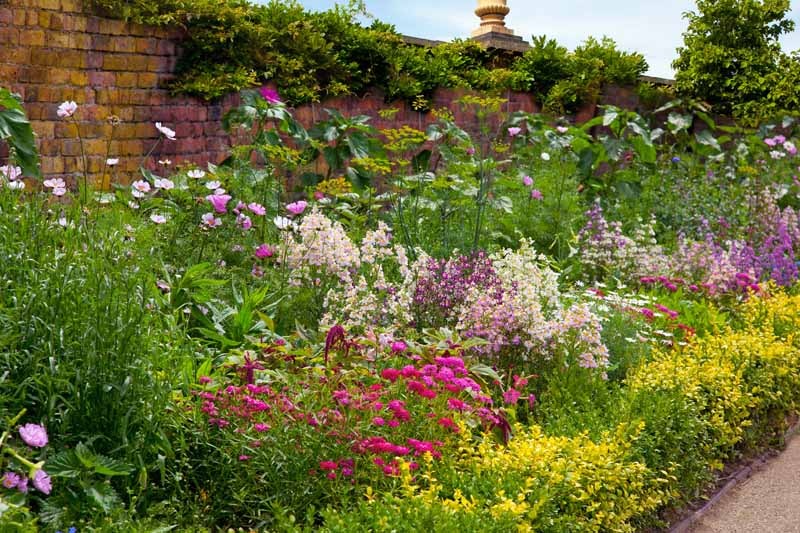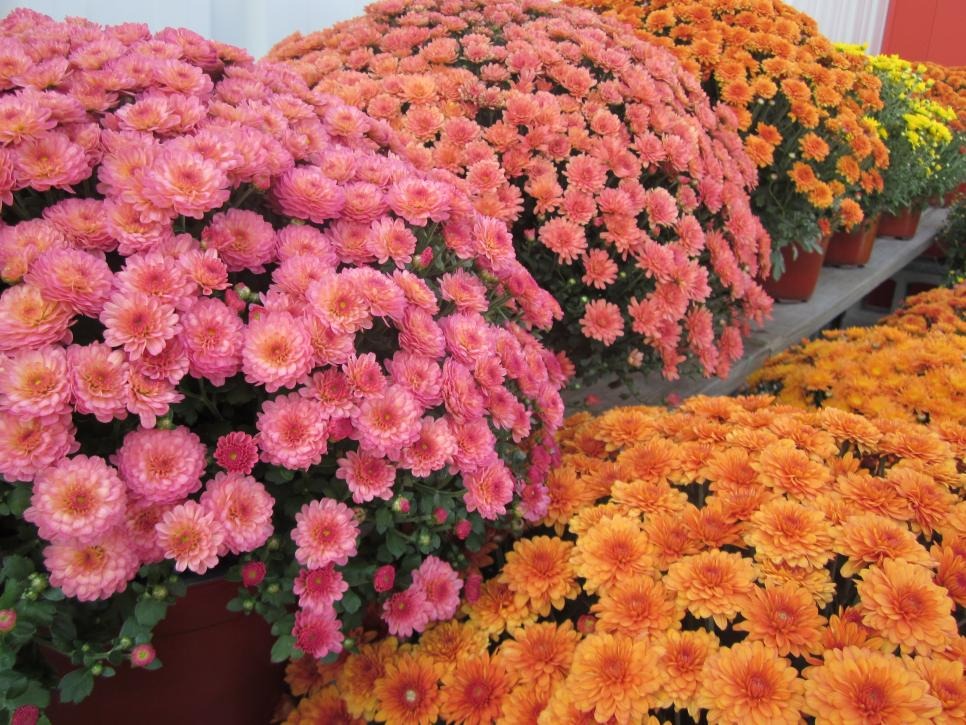Fall flower gardens can be spectacular with bold combinations of jewel-toned colors, including purple, rust, scarlet, and gold. To have an abundance of flowers in the fall, you need to do some planning early in the gardening season.
For fall flowers to thrive in your garden, plant them in the spring or early summer, so they have time to become established. Besides selecting plants that have a after bloom period, check their growing zones to be certain they will bloom in your area before frost hits. Your local nursery can offer advice if you are unsure.
Here are 14 fall-blooming perennials in a variety of colors for your garden.
01. Autumn Crocus (Colchicum autumnale)
You might be familiar with the spring-blooming crocus, but this little beauty does not put on its show until fall. Autumn crocus grows best in partial shade, and a little dampness is welcome. It grows only a few inches tall and makes a wonderful carpet scattered under trees and along walkways. For healthy plants, reduce watering in midsummer when the foliage starts to die back and yellow, and resume watering to keep the soil moderately moist in the after summer when the foliage gets green again.
02. Balloon Flower (Platycodon grandiflorus)
Balloon flower is in the Campanulaceae family, but its flowers are a bit more dramatic. While it mostly blooms in the summertime, it also can bloom in the fall if you deadhead it (remove spent blooms). It starts off as a puff or bubble and pops open when it is ready to bloom. Balloon flower is a profuse bloomer. And the plants spread slowly, filling in without becoming a nuisance. Other than cutting the plants back in the spring or fall, virtually no other maintenance is required.

03. Blue Mist Shrub (Caryopteris x clandonensis)
The blue mist shrub is often grown in the perennial garden and typically blooms in after summer or fall. It slowly opens its blossoms with dazzling flower clusters that butterflies and bumblebees love. The blue mist shrub should be cut back in early spring to maintain its size and shape and to remove any dead or ailmentd portions. The plant blooms on new wood, and the gray-green foliage is attractive all season.
04. Goldenrod (Solidago)
Goldenrod is one of the last flowers to bloom in the fall, with its bloom period generally stretching from August to October. There are more than 100 species in the goldenrod family. The plants typically reach around five feet tall and display clusters of tiny yellow flowers at the tops of their stems when they are in bloom. Bees and butterflies love these flowers. Goldenrod is fairly low-maintenance and can be an aggressive spreader in the garden. So if you want to control its spread, remove the flower heads before they go to seed.
05. Japanese Anemone (Anemone x hybrida)
Japanese anemone starts blooming in after summer and goes straight through until frost. The paper-like blooms are white or pink with yellow stamens in the center, and they’re known to attract butterflies. This plant requires little maintenance once it’s established, though some taller plants might need staking to prevent flopping. Plus, if you live in a cooler part of its growing zone, it can be helpful to add a layer of mulch prior to cold weather to keep the roots warm.
06. Joe Pye Weed (Eutrochium purpureum)
Joe Pye weed is a native plant that grows in erect clumps of up to six feet tall. It can make a wonderful backdrop to a garden border. In midsummer to early fall, tiny mauve blooms appear in round clusters or florets. Each plant has around five to seven of these florets, and the flowers give off a light vanilla scent. To prevent the plants from becoming overgrown and flopping over, cut them back in the after winter.

07. Mums (Chrysanthemum)
Mums are a common sight of fall in the garden, with their brilliant and profuse blooms. While mums are showcased in garden centers in the fall, if you plan to grow yours as a perennial, it’s best to get mums in the ground in the spring to become established before cold weather hits. Make sure your plant is well watered, especially in hot weather. And put a layer of mulch around the planting site before prior to cold weather to keep the roots warm. (The mums you’ll see at grocery stores in fall are known as “florist mums.”)
08. New York Aster/Michaelmas Daisy (Astereae)
These delicate daisy-like blossoms start popping open in after August and continue until frost. Pinching back the stems in the early summer can turn these plants into dense mounds with dozens of flower buds. The many Astereae varieties range in size from eight inches to eight feet; the taller varieties should be staked to prevent them from flopping over.
09. Russian Sage (Salvi yangii)
Russian sage flowers can last for weeks, with the plant typically blooming at the end of the summer to early fall. The blooming begins slowly, and the flower color gets more brilliant as the small blooms fully open. Pruning should be done in the after winter to early spring, as the flowers form on new growth. Make sure to pick a planting site with full sun, as too much shade can cause the plants to flop over.
10. Sneezeweed (Helenium)
Sneezeweed blooms look like small, russet-toned coneflowers. Many can grow quite tall and will need to be staked or pinched. The plant likes cool feet and hot heads, meaning you should use mulch to keep the roots cool but plant it in full sun to keep the top of the plant warm. Plus, while the plant prefers good drainage, it can tolerate poorly drained soil, such as clay.

11. Stonecrop (Sedum)
Stonecrop comes as close to perfection as any plant can. It looks good all year, requires minimal maintenance, and attracts few problems. The only drawback of stonecrop is it’s not deer resistant. Pruning your plant in early July can encourage bushier and sturdier growth.
12. Sunflower (Helianthus)
Many gardeners are familiar with annual sunflowers, which can grow up to 12 feet tall and display plate-size flowers. But Helianthus is a large genus of flowers that can be perennial and bloom toward the end of the season. The perennials generally produce smaller daisy-like flowers than the annuals. But there will be plenty of them. And they won’t topple over like the large annual sunflowers tend to do. Maintenance is fairly low for these plants, but you should keep them well watered and use fertilizer if you have poor soil.
13. Tickseed (Coreopsis)
The Coreopsis genus is home to many popular garden plants. Most bloom periodically throughout the summer season. But if you prune back your plant after it flowers it will put on a glorious fall floral display. Bees and butterflies tend to love the daisy-like blooms. Most ailments and pests avoid the plant. Watering usually isn’t essential unless you go for a long stretch without rainfall.
14. Turtlehead (Chelone lyonii)
Chelone lyonii got its common name from its blossoms, which are shaped like turtles’ heads. It is a fall-blooming perennial that does not handle excessive dry heat well. But it is perfect for a damp area in your garden. Turtlehead is not unruly. It grows in a dense clump with attractive foliage and flowers that bloom for weeks. You can prune it lightly to shape it in the after fall or spring. Hummingbirds and butterflies visit it for nectar.




